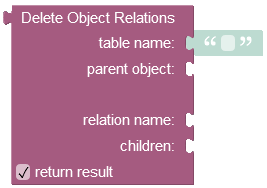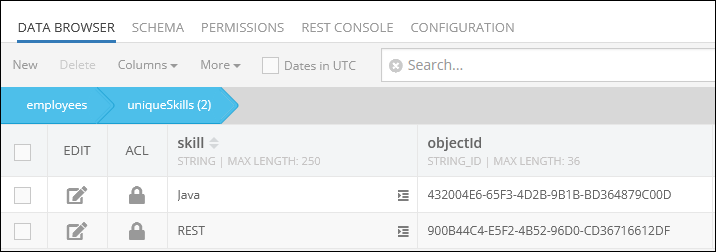Delete Objects from relation¶
The API removes specific objects from a relationship with their parent.
Blocking API¶
Integer result = Backendless.Persistence.of( "TABLE-NAME" ).deleteRelation(
Map parentObject,
String relationColumnName,
Collection<Map> children );
Integer result = Backendless.Persistence.of( E ).deleteRelation(
E parentObject,
String relationColumnName,
Collection<T> children );
Non-Blocking API¶
Backendless.Persistence.of( "TABLE-NAME" ).deleteRelation(
Map parentObject,
String relationColumnName,
Collection<Map> children,
AsyncCallback<Integer> callback );
Backendless.Persistence.of( E ).deleteRelation(
E parentObject,
String relationColumnName,
Collection<T> children,
AsyncCallback;<Integer> callback );
where:
| Argument | Description |
|---|---|
TABLE-NAME |
Name of the table where the parent object is stored. |
E |
Java class of the parent object. The class name identifies the table where the parent object is stored. |
parentObject |
The object for which the relation with the specified children will be deleted. When this argument is an instance of java.util.Map (for the map-based approach), it must contain the "objectId" property. |
relationColumnName |
Name of the column identifying the relation. Relationship between the specified objects from the children collection will be deleted for the column in parentObject. |
children |
A collection of child objects for which the relationship with the parentObject will be deleted. |
callback |
A responder object which will receive a callback when the relation has been deleted or if an error occurs. Applies to the asynchronous method only. |
Return Value¶
Number of child objects for which the relationship has been deleted. The asynchronous call receives the return value through a callback executed on the AsyncCallback object.
Example¶
The example below deletes a relation between a Person object and its children. The child objects are referenced explicitly in the API call (see the object IDs in the collection as "XXXXX-XXXXX-XXXXX-XXXXX" ``and`` "ZZZZ-ZZZZ-ZZZZZ-ZZZZZ").The relation column is address.
HashMap<String, Object> parentObject = new HashMap<String, Object>();
parentObject.put( "objectId", "41230622-DC4D-204F-FF5A-F893A0324800" );
HashMap<String, Object> childObject1 = new HashMap<String, Object>();
childObject1.put( "objectId", "XXXX-XXXX-XXXX-XXXXX" );
HashMap<String, Object> childObject2 = new HashMap<String, Object>();
childObject2.put( "objectId", "ZZZZ-ZZZZ-ZZZZZ-ZZZZZ" );
ArrayList<Map> children = new ArrayList<Map>();
children.add( childObject1 );
children.add( childObject2 );
Backendless.Data.of( "Person" ).deleteRelation( parentObject, "address", children,
new AsyncCallback<Integer>()
{
@Override
public void handleResponse( Integer howManyObjDeleted )
{
Log.i( "MYAPP", "relation has been deleted" );
}
@Override
public void handleFault( BackendlessFault fault )
{
Log.e( "MYAPP", "server reported an error - " + fault.getMessage() );
}
} );
Person personObject = // personObject retrieval is out of scope in this example
Address addressObject1 = // addressObject retrieval is out of scope in this example
Address addressObject2 = // addressObject retrieval is out of scope in this example
ArrayList<Address> addressCollection = new ArrayList<Address>();
addressCollection.add( addressObject1 );
addressCollection.add( addressObject2 );
Backendless.Data.of( Person.class ).deleteRelation( personObject, "address", addressCollection,
new AsyncCallback<Integer>()
{
@Override
public void handleResponse( Integer howManyObjDeleted )
{
Log.i( "MYAPP", "relation has been deleted");
}
@Override
public void handleFault( BackendlessFault fault )
{
Log.e( "MYAPP", "server reported an error - " + fault.getMessage() );
}
} );
Codeless Reference¶

where:
| Argument | Description |
|---|---|
table name |
Name of the table where which contains the parent object as identified by parent object. |
parent object |
Id of the object for which the relation will be deleted. |
relation name |
Name of the column which identifies the relation within the parent table (identified as table name). |
children |
Represents a list containing unique identifiers(objectIds) of the children objects relations that must be deleted from the data table. |
return result |
When this box is checked, the operation returns the number of removed child objects relations. |
Returns the number of removed child objects relations.
Consider the first object with one-to-many relations(skills column) in the parent data table called employees:
By clicking the record (1:N Relations) in the skills column of the parent data table presented above, you get redirected to the child data table called uniqueSkills, where you can see the related children objects:

Suppose you want to remove two relations. The following example demonstrates the removal of the Objective-C and Javascript relations from the parent object:
The objectId values for each relation are:
-
Objective-C:"4E205196-59B0-45A6-BACB-303A66BEFF22" -
Javascript:"D08FA6A7-4534-4B43-AF06-BC4CBFE54C60"

After the operation runs, the Objective-C and Javascript relations get deleted.
